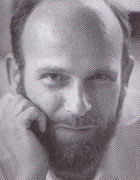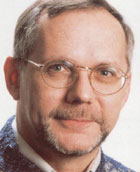2006 Spring Festival - The test pieces
9-May-20064BR looks at the three works being used this weekend to test the bands on their quest to reach Symphony Hall.
Grand Shield:
 Whitsun Wakes - Michael Ball
Whitsun Wakes - Michael Ball
Whitsun Wakes was commissioned by the BBC and first performed by the Black Dyke Mills Band conducted by James Watson at the Bridgewater Hall in Manchester in May 1997 and it was subsequently chosen as the test piece for the British Open of 1997 which was initially postponed due to the death of Princess Diana and actually took place in the January of the following year.
It has been chosen in 2002 as the set work for the Regional Championships and by cruel irony coincides with the death of yet another princess - this time Margaret, the Queen's errant and colourful sister.
The composer writes that the work is a tribute to the Lancastrian towns of his youth who would celebrate the Whitsun weekend, by either observing and taking part in the traditional Whitsun Walks or decamp to the seaside to enjoy themselves. Thus there is a strong element of the processional march and hymns of the non conformist churches and a sense of excited revelry as he workers enjoy the rides and pubs of a forever sunny Blackpool pleasure beach.
Finally there is an element of reflective sadness in the music as the composer returns in musical thought to the Belle Vue Championships of yesteryear and the memories he had of his grandfather who was a lover of bands and their music and who was a devotee of the Sandbach based Fodens band, a band that in his youth was nigh on unbeatable.
Ball himself is a very clever and thoughtful composer for bands and his works have clear musical lines of progress whilst still leaving the conductors space to add their own expressions through musical thought and flexibility. Whitsun Wakes is a fine piece and a fine test.
As ever the music starts as it means to go along and the scoring at the start is full and broad and requires ensembles within the band to create large rounded well balanced sounds - hallmarks of the great bands of the bygone past. The first of the echoes starts on the solo cornet before the build up to an exciting passage at Figure 4 marked Fast and Vigorous crotchet = 168. This is technically difficult, but well within the capabilities of the very best bands and there will be a need for the paying to remain neat and clean as well as down right fast.
After a quick bit of a breather at Figure 6 it's up and at 'em again at Figure 7 and although there doesn't seem time to find and explore the detail there are very precise markings on nearly every bar of notes that bring a sense of style and pulse to the music. It's not crash bang wallop music in any sense and it is a very cultured speed - a bit like an Aston Martin at full revs.
Some of the trickiest playing comes in the intervals and jumps in the main lines through 8 - 10 and only bands with the players with iron cast technique will make this sound brilliant. It could be split city very easily.
Figure 13 starts a fugue of sorts as the playful theme is passed from euph to cornet to bass to flugel before things hot up to a sprint to the first of the small interludes at Figure 16. Here the timpanist holds the key whilst the composer tests the dynamic control of the band in a series of alternating loud and soft chords and the music returns to those echoes as the cornet, sop and most importantly the rep and horn have the opportunity to show off their class.
The flugel in particular ends things with a cadenza libero of immense difficulty that sails to a top C and back and set the tone for what follows.
Figure 20 onwards is a loving look back o those old test pieces that took their inspiration from the orchestral and operatic selections that were the staple diet of the competing bands at the turn of the 20th century and the trombone and solo cornet set out their stalls, before they are joined by the euph who with the solo cornet develops an extensive romantic duet that is not only musically but also technically taxing.
Figure 22 sees a very difficult passage of technical playing that starts with the third cornet and ends on the baritone before another short interlude and the hymn tune section of the Whitsun Walks and the move through the gears to imitate the Whitsun March through a small Lancashire town.
Then comes the testers for the soprano (up to top C and down to low bottom G) and baritone (Top C start) before the build up to the end starts at Figure 32. It cranks up through the gears along here and it's all pretty exciting stuff before we come to a halt at Figure 37 and a reprise of sorts of the very beginning and a last test of lips and stamina. The end comes pretty quick with lots of loud and very high playing on the cornet section before a real declamatory chord and pause leads to a downward spiral of quavers and a last bash out of chords before the last (very big) chord.
A great test and one that should sort out the men from the boys. Lets hope the judges get it right.
Senior Cup: Harmony Music – Philip Sparke
Harmony Music – Philip Sparke
Harmony Music was commissioned by Boosey and Hawkes Band Festivals Ltd for the 1987 National Brass Band Championships of Great Britain, which was won by the Desford Colliery Dowty Band conducted by James Watson.
The title is both a play on the German "Harmoniemusik" with all its associations with bands in general as well as a reference to the overall tonal harmonic language of the piece. The piece opens quietly with a long unison crescendo, interupted by upward rushes from the basses and trombones which introduce a fanfare like passage from the cornets. A sonorous chorale follows which builds from the lower band to a tutti climax.
There is a brief hint of faster music but before this is an immensely difficult euphonium cadenza which reaches both extremes of the instruments range. The Motlo Vivace is fast and furious as well as Francophile in style before the music subsides to a haunting homage to the composer Maurice Ravel which incorporates two accompanied cadenzas for cornet and horn. The opening returns before a shuddering climax that is tumultuous.
The soprano and trombones try in vain to stop the chaos before a Presto Coda ends the work. Even some 19 years after it was written it is a piece that requires immense amounts of skill and talent from both players and MD to make come off, and remains one of the composers most accessible and popular compositions.
Senior Trophy: The Essence of Time – Peter Graham
The Essence of Time – Peter Graham
Peter Graham wrote 'The Essence of Time' as the set work for the 1990 European Championships which were held in Falkirk in Scotland in 1990. Since that time it has proved to be one of the most popular test pieces for bands at the Championship and First Section level.
The piece takes it's inspiration from The Book of Ecclesiastes, Chapter 3 and commences: "To every thing there is a reason, and a season, and a time to every purpose under the heaven; a time to be born; a time to dance; a time to love; a time to hate; a time to die; a time to mourn; a time for war; a time for peace."
It is in effect a piece based on variations on a central theme which attempt to portray the individual characteristics of the moods of the activities listed. 'The Essence' is left to the interpreter and the listener to decide.
Although not seen as the most technically challenging of test pieces it is musically one of the most satisfying to listen to – the variations are both superbly constructed and rounded to feature both individual and ensemble strength and weaknesses. It requires an understanding of the composer's intentions and punishes those who indulge too much in over theatrical musical posturing. It has a beautiful simplicity in many of the more subdued movements whilst the faster variations are bright and witty.
It was used at the Grand Shield Contest in 1992. It has also been used as the First Section set work for the Pontins Championships in 1998 and as the National Championship First Section Finals test piece in 1994.















